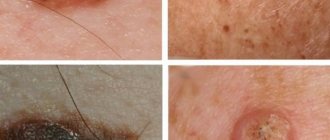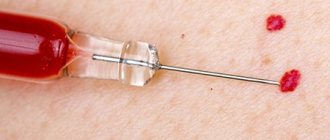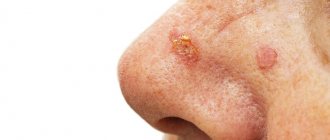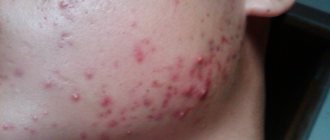Author - Sergey Aleksandrovich Tverezovsky
, surgical oncologist, mammologist, oncodermatologist, candidate of medical sciences, doctor of the highest category.
Cutaneous keratoma
is a general collective name for several types of benign skin tumors. In fact, it is a benign tumor growing from the surface layer of the skin - the epidermis. The cells of this layer are called keratinocytes, and tumors from them are called keratomas.
Normally, there is a certain balance between the formation of new skin cells and their desquamation. When this balance is disturbed, due to various reasons, a special type of benign skin tumors is formed in such places - keratomas.
Types of keratomas
Senile (age-related, senile) keratoma
is a gray-whitish formation that goes through stages from a spot to a plaque with crusts on the surface. With equal frequency, senile keratoma occurs in both men and women and is localized on any area of the skin.
Seborrheic keratoma
– a slow-growing and slowly rising above the skin level (corresponding to the process of keratinization of the surface) plaque-like structure, often with clear, less often with blurred contours. The surface becomes keratinized and cracks, the color of the keratoma changes towards dark - gray-brown.
Horny keratoma or cutaneous horn
- a formation that has a conical or linear shape, rising above the skin level in the form of a horn or spike. A feature of this type of tumor, as well as transitional tumors similar to it, is an increased risk of malignancy into squamous cell carcinoma.
Follicular keratoma
- a rarer formation of gray-pink color, more often occurring in women, localized on the upper lip and on the skin of the forehead, neck, and near the hairline.
Solar, solar keratoma
or
actinic keratosis
- these neoplasms appear on areas of the skin exposed to direct sunlight (face, neck, outer side of the upper and lower extremities, upper back and chest), in the form of multiple dense foci of hyperkeratosis of light brown and dark brown color which are covered with grayish dry scales. Solar keratoma can also degenerate into basal cell carcinoma, squamous cell carcinoma, and melanoma of the skin. Any of the above types of formations can be either single or multiple.
How dangerous is a keratoma?
For the most part, keratomas do not pose an oncological risk.
As mentioned above, keratoma keratoma and solar keratoma have an increased risk of malignancy. But what else is the danger of these skin formations? The fact is that even an experienced doctor is not always able to distinguish a keratoma from a malignant neoplasm using clinical methods.
Many malignant tumors at various stages of their development are similar to keratomas. Therefore, in all cases it is necessary to contact a dermatologist-oncologist; only a specialist can correctly diagnose and determine treatment tactics.
Also, keratomas can be dangerous due to complicated course. In the early stages of development, they cause only aesthetic inconvenience (which is important for women or when multiple keratomas are located in open areas of the body). But after the appearance and intensification of keratinization on the surface of the formations, additional complaints may occur - itching, pain, tingling in the area of the keratoma, with deep cracks and injury - the addition of an infection and the occurrence of inflammation, suppuration, with trauma and part of the crusts coming off the surface - severe bleeding.
To summarize: treatment of keratoma is necessary if malignant degeneration is suspected, with a complicated course, with rapid growth, as well as with aesthetic problems.
2.Classification
Keratomas are classified according to a number of characteristics:
- senile keratoma (gray-white growth on an open area of the body, prone to inflammation);
- seborrheic keratoma (the most dangerous type of growth, which turns brown over time, causes itching and peeling);
- horny keratoma (usually a strongly protruding, small diameter, but tall, dark-colored growth that can degenerate);
- solar keratoma (multifocal keratoma, most often affecting exposed skin in men over 40 years of age, dangerous for asymptomatic degeneration into cancer);
- follicular keratoma (growth on the scalp or upper lip, more common in women).
Visit our Dermatology page
Removal of keratomas: choice of treatment method
How to get rid of keratomas?
The doctor always chooses a method of elimination depending on the type of keratoma, its size, location, as well as the patient’s preference, his qualifications and equipment.
The appointment is conducted by an expert class doctor - oncologist surgeon, oncodermatologist, candidate of medical sciences, doctor of the highest category Sergey Aleksandrovich Tverezovsky.
Effective ointments for the treatment of keratosis
The main causes of keratoma are associated with age-related changes in the epidermis. They do not pose a health hazard, but cause serious aesthetic discomfort.
You can fight skin tumors at home using pharmaceutical ointments. Medicines help reduce senile tumors and reduce their number, exfoliate and soften the skin in the area of keratomas.
| Medicine | Active substance | Manufacturer | average cost |
| Papilleque | Celandine extract, acetic acid | KP KOS "Pharmaceutical Factory", Kyiv, Ukraine | 300-380 rubles |
| Solcoderm | Nitric acid, acetic acid, oxalic acid | MEDA Pharmaceuticals Switzerland GmbH | 815-1050 rubles |
| Aldara | Imiquimod | 3M Health Care Ltd (UK) | 4400-4680 rubles |
| Methotrexate | Methotrexate | EBEWE Pharma (Austria) | 190-350 rubles |
| Bleomycin | Bleomycin | Nippon Kayaku Co. (Japan) | 1500-1550 rubles |
| Fluorouracil | Fluorouracil | EBEWE Pharma (Austria) | 200-230 rubles |
| Flucinar | Fluocinolone acetonide | LLC VALEANT, Russia | 250-260 rubles |
| Fluorocort | Triamcinolone acetonide | JSC "Gedeon Richter", Hungary | 215-240 rubles |
When selecting the most effective drug, you must make sure that these are keratomas and not warts or papillomas. You can get rid of small, isolated tumors yourself. In case of multiple lesions of the skin or affecting the deep layers of the dermis, surgical removal methods are used, most often with a laser.
Treatment with Papilleq
Papillek is one of the most effective pharmacological drugs for the removal of senile keratomas. Thick oil contains extract from celandine, extracts of medicinal plants, citric and acetic acids, potassium and polysaccharides.
Papillectomy affects not only keratomas, but also warts, calluses and papillomas.
To remove tumors, the medication should be applied to clean skin, being careful not to get on healthy skin. The medication should be left until completely dry for 15-20 minutes; the medication should be washed off only after 10 hours. If necessary, the application site can be sealed with a band-aid - this does not affect the effectiveness of the product. Papilleque is applied to the tumors every other day.
Affected skin must be treated for at least 14 days. Papillectum affects the epidermis according to the principle of chemical peeling - it effectively exfoliates the stratum corneum of the skin and accelerates the process of regeneration of its cells.
The drug is used for extensive keratosis, when other medications have proven ineffective. When applying Papilleka to the skin of the eyelids, you must be careful to ensure that the medicine does not get into your eyes.
Treatment with Solcoderm
Solcoderm is a drug recommended for use if the keratoma is seborrheic. This pharmacological agent has pronounced bactericidal properties. The medication is used to remove benign tumors. When regularly applied to affected areas of the skin, Solcoderm causes gradual mummification and death of the altered tissues.
When using Solcoderm, the tumor begins to dry out, acquire a brownish-black tint and fall off. After using the medicine, no scars remain. The medication accelerates the process of renewal and regeneration of damaged tissue, resulting in clean, healthy skin at the site of the tumor.
It is recommended to apply Solcoderm directly to the affected area, after cleaning it with alcohol. It is necessary to ensure that the medicine does not come into contact with healthy skin.
The drug may cause side effects - redness or the appearance of a white “ring” of the skin around the site of application of Solcoderm. This is a temporary reaction of the epidermis that disappears on its own and does not require medical intervention.
Aldara against keratomas
Aldara is a drug for external application based on the active ingredient imiquimod. The medication has an antitumor effect. It does not directly affect viruses that cause skin tumors, but stimulates local immunity. Thanks to this, cells of the immune system are activated, the process of renewal and regeneration of affected tissues is accelerated.
Aldara is used to remove senile keratomas on the face and body, papillomas, warts, genital warts, and basal cell carcinomas.
The medicine must be applied exclusively to the site of the skin tumor, rubbing with light movements until completely absorbed. Aldara should be applied in the evening, before bedtime, and the ointment should be left for 9-10 hours. The medication is used three times a week.
The product applied to the skin should not be covered with a patch or bandage. After the specified time has expired, Aldara is washed off with plenty of warm water and soap. Depending on the number and severity of skin lesions, treatment will take 12-16 weeks.
Application of Prospidin ointment
Prospidin ointment is a non-hormonal, antitumor, cytostatic drug. Available in the form of a thick white emulsion for external application, intended for the treatment of keratomas, papillomas, basiliomas, and melanoma.
With regular use, Prospidin has a pronounced alkylating, anti-inflammatory, and hypotensive effect on the epidermis, preventing the further development of benign neoplasms.
The active substance contained in the drug acts directly on the tumor at the cellular level, destroying it. As a result, the keratoma shrinks and completely disappears.
For treatment, Prospidin ointment must be mixed with lanolin or vegetable oil, then applied to the area of the tumor and secured with a sterile bandage on top. The medicine should be applied to the skin once a day for 3-4 weeks.
Prospidin has several contraindications for use - the ointment cannot be used during pregnancy and breastfeeding, for kidney and liver diseases, cardiovascular pathologies, as well as in case of individual intolerance to the medication.
Treatment with Metatrexate
Metatrexate Ebeve is an anticancer drug with immunosuppressive effects. The pharmacological agent acts on the DNA of skin neoplasm cells, stopping their further reproduction - as a result, the keratome stops growing and begins to decrease in size. The drug is also prescribed for the treatment of malignant neoplasms of the skin.
Methotrexate Ebeve has a number of contraindications for use:
- presence of alcoholism;
- renal and liver failure;
- tuberculosis;
- HIV;
- stomach or duodenal ulcer;
- all trimesters of pregnancy and breastfeeding;
- hypersensitivity to the active components included in Metatrexate.
The most effective solution in the treatment of age-related formations is the Metatrexate Ebeve solution, which is injected locally, directly into the neoplasm tissue. The dosage of the drug is selected individually, depending on the extent and severity of skin lesions.
Application of Fluorouracil
Fluorouracil ointment is a drug intended for the treatment of benign and malignant skin tumors. The pharmacological agent belongs to the group of antimetabolites and contains the active substance fluorouracil at a concentration of 5%.
The drug has a rapid anti-inflammatory effect, inhibiting chemical processes that contribute to the growth of skin tumors. Fluorouracil blocks the formation of DNA structures in the neoplasm, as a result of which it begins to decrease in size and its further development stops.
Fluorouracil ointment is applied to the affected skin at a dosage of 0.5 g for 5 days, after which it is necessary to take a break for 30 days and continue treatment according to the same regimen.
In the most severe and advanced cases, the dosage of the drug can be increased to 0.6 g. Fluorouracil ointment is applied to the affected skin once every 7 days, the duration of treatment in such cases is 8-12 weeks.
The drug should not be used during pregnancy and breastfeeding, during exacerbation of peptic ulcer disease, in the presence of anemia, herpes and chicken pox, as well as in case of hypersensitivity to fluorouracil.
Colchamine ointment
Colchamine ointment is a non-hormonal drug for external application with cytostatic and anti-inflammatory effects. The pharmacological drug is used to treat age-related keratomas, papillomas of viral origin, as well as oncological skin lesions.
With regular use, Colhamin ointment has an effective anti-inflammatory and anti-miotic effect, stopping the development of neoplasms on the face at the cellular level. The medication also contains the antibacterial component syntomycin, which destroys pathogenic bacteria.
It is recommended to apply colhamine ointment to the affected area of skin in a thin layer, then secure the medicine with a gauze bandage and adhesive tape. Before applying the medication, the epidermis must be cleaned and dried. The product is applied every day; 10-14 days are enough to get rid of keratoma.
The main contraindications to the use of Colhamin ointment are a wound or ulcer at the site of application, the patient’s age under 18 years, all trimesters of pregnancy and lactation, as well as hypersensitivity to the active ingredients in its composition.
Laser removal of keratoma
The most common, delicate, low-cost and aesthetic option for eliminating keratoma is laser removal (our clinic uses a fractional CO2 laser).
We also use radio wave, electrocoagulation and surgical methods for removing skin keratoma, and use a combination of laser and radio wave elimination methods. The procedure for removing keratoma should be quick, painless, and least expensive, so that the patient receives the maximum aesthetic effect with a minimum recovery period. Both the laser or radio wave method and their combination completely solve these issues.
Laser removal of keratomas is performed on an outpatient basis, immediately after examination and digital dermatoscopy and has many advantages:
- Speed. Removal occurs not even in a matter of minutes, but literally in seconds;
- Painless. We use local anesthesia, and for small forms of keratomas, an application method of pain relief is possible;
- Complete sterility;
- Ease of wound care;
- Fast healing. For small keratomas it is 4-5 days, and for large ones - 2-3 weeks.
Keratoma: how to treat?
To help the patient get rid of keratoma or actinic keratosis, the doctor prescribes a conservative or surgical treatment method. If drug therapy does not produce results, if the location of the formation is unsuccessful, if it is perceived as a cosmetic defect, surgery to remove the keratoma is prescribed.
Drug therapy
Drug treatment involves the use of various ointments, solutions or emulsions with active substances. It is immediately important to note that such methods are effective in the initial stages, when the stain has just appeared. Therapy must be prescribed by a doctor. Self-medication is strictly not recommended, as it can cause complications in the form of damage to surrounding healthy tissue.
Keratoma: how to remove surgically?
The keratoma is surgically removed using one of the following methods:
- laser method;
- cryodestruction;
- radiosurgery method.
The leader of choice is laser removal, since it minimizes the risks of negative consequences, bleeding, wound infection, and relapses. In a few minutes the formation is completely removed. And the wound heals within a few days.
Possible risks
Attempts to remove the keratoma yourself by tying it with thread or cauterizing it with aggressive media are strictly prohibited. This can lead to serious consequences, including the degeneration of a benign tumor into cancer.
Radio wave removal of keratoma
A modern and effective method that has advantages similar to laser. Removal of keratomas using the radio wave method does not require special preparation. It is bloodless and non-contact; it can be used to eliminate skin tumors in delicate areas, for example, to remove keratoma on the face without scars.
Is it possible to remove a keratoma surgically?
Surgical treatment of keratomas is also used, although very rarely.
Excision is performed under local anesthesia on an outpatient basis, accompanied by the application of a neat cosmetic suture. An oncologist surgeon and oncodermatologist at our clinic uses excision for large keratomas - more than 4-5 cm, as well as when a malignant process is suspected. In all other cases, it is advisable to use more delicate, low-traumatic and aesthetic methods - laser and/or radio wave removal.
At the end of the discussion of removal methods, it is necessary to clarify once again - removal of keratomas should be carried out by an oncologist-dermatologist only after the required minimum preoperative examination (digital dermatoscopy, sometimes biopsy). Only after making sure that the skin formation is not malignant can you begin to eliminate it.
In each specific case, we decide on the need to send a remote lesion for histological analysis.
Removing keratomas at home
Removing keratomas at home is categorically unacceptable, since the patient is not able to independently assess the degree of aggressiveness of the process, as well as adequately eliminate the formation. The risk of getting a serious and sometimes life-threatening complication is extremely high. Do not self-medicate, trust your health to professionals.
4.Treatment
The following treatment methods are used:
- Taking heavy doses of vitamin C. This does not destroy existing keratomas, but is a good prevention of the appearance of new ones.
- External hormonal agents. Local hormone therapy in the form of ointments reduces inflammation and disrupts the blood supply to the keratoma, slowing its growth.
- Intensive protection against tanning, as the main factor in the appearance and enlargement of keratomas.
- Diet. Replacing animal fats with vegetable fats in the diet.
- Sometimes it is recommended to pay attention to constant stress factors (quitting a job, normalizing family relationships).
Based on the results of the examination, keratoma removal is most often prescribed, especially if the keratoma is constantly peeling off, injured or exposed to solar radiation. Modern medicine offers several ways for this:
- laser removal;
- cryodestruction;
- radiosurgery;
- surgical excision.
Sometimes folk remedies are used to treat keratoma, but they are not very effective and, at best, lead to a slowdown in growth, but not to the disappearance of the keratoma. At the same time, some aggressive folk methods of self-medication contribute to the transformation of education into malignant.
Prevention of keratomas includes moderation in sun tanning and its complete exclusion during the most dangerous hours of the day, proper nutrition, adequate sleep, giving up bad habits and a sedentary lifestyle, reducing and avoiding stressful situations, a balanced diet rich in vitamins.
Our recommendations for gentle skin care:
- Do not expose your skin to friction or pressure.
- Avoid contact with chemicals, including household chemicals, on your skin.
- Be careful when working in the country - juices and pollen of harmful poisonous plants should not come into contact with the keratoma.
- Senile keratoma should not be exposed to ultraviolet irradiation. Apply sunscreen, wear wide-brimmed hats, closed clothing made of lightweight fabrics, in short, choose the protection methods that suit you.
- Try to eat as little junk food as possible that contains carcinogens and other harmful substances. Give preference to plant foods, reduce your consumption of meat (especially red).
And finally, we note once again - if you have a keratoma, do not self-medicate, but consult a doctor.
But following the general principles of proper nutrition, trying not to injure the tumor, not exposing it to sunlight and following other methods of preventing its growth is not only possible, but also necessary. We are always there and ready to help. Book a consultation with an oncodermatologist right now by calling the clinic: +7 (812) 952-83-73, and you will be able to undergo a thorough diagnosis and remove skin keratomas in 1 visit.
Reasons for appearance
The exact causes of the disease have not yet been established. The main one is regular exposure to ultraviolet radiation. It affects the dermis, epidermal layers, blood vessels, sebaceous glands, and melonocytes.
Gradually, under the influence of sunlight, the disturbances increase, reaching the peak of the disease.
The following factors contribute to the development of pathology:
- genetic predisposition;
- weakened immune system;
- influence on the skin of chemicals (resinous substances, oil, sand, etc.);
- past infections;
- age-related changes (the disease most often affects people over 50 years of age).
Due to weak immunity, AIDS carriers, people with problems with the nervous and endocrine systems, as well as patients who have undergone chemotherapy or complex operations are more prone to the appearance of keratosis.
Some types of keratoses often affect young people. This usually applies to red-haired or fair-haired people with gray, blue or green eyes. Research shows that by the age of 40, 60% of the population has at least one element of keratosis.
Over the age of 80, everyone has some type of this pathology.










